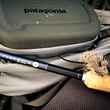Tenkara has proven itself to be a simple, yet incredibly versatile form of fly-fishing, which has helped properl the rise in all forms of tenkara equipment since the sport’s stormy uptick that began roughly in 2009, when the name was still exotic and unfamiliar to most. The simplicity, beauty and effortlessness of tenkara has since gained many followers, from previously avid fly-fishermen to beginners and debutants alike. However, one natural challenge to tenkara anglers has limited its use: wind. Oh, the many groans of tenkara anglers that can be heard when a breeze settles in on the river.
A conventional fly rod, as we all know, has a weighted line, whereas tenkara lines unfortunately do not have nearly as much weight. Thus, casting with such little weight in blustery winds can seem quasi-impossible. But this problem is indeed solvable and, in doing so, I have experimented with different line structures, casting styles and rod lengths; below I have detailed my recommendations to achieve tenkara casting results in the wind that are similar to what can be acheived with a traditional fly-fishing setup.
Casting style is very important
For those of us who have been kite surfing before, you know it is simply impossible to ride ‘into’ the wind. Similarly, a tenkara fly will not be cast ‘into’ the wind with a regular setup. Instead, a more thoughtful casting technique must be used. Like a kite surfer, the wind must aid the cast, not hinder it. This is entirely possible with tenkara, just let the fly line unroll high up behind you, harnessing the power of the wind. Then, simply parachute your cast, using a wrist flick, down onto the water’s surface from above, aiming several inches above the intended target. This technique will avoid the line coming straight back at you and can achieve very significant results.
Traditional tenkara lines are just not up to the task
I have experimented with a modified tenkara line setup and have attained great results. This line uses 7-8 feet of #2-3 fluorocarbon tenkara level line, knotted to an approximately 2 foot long RIO Powerflex Shooting Line (or equivalent). This is then joined with a 6 inch segment of 1x fluorocarbon to which you would knot around 2-3 feet of tippet appropriate to your fishing. The shooting head here allows for more weight distribution to the front of the cast, and helps anchor the line in the water when holding the rod up high in the traditional tenkara style.

Rod Length and stiffness is paramount
It is not making life any easier if you attempt to cast in windy conditions with the shortest rod available. Instead, go out there with your longest rod, not only will this help your casting, but it will also increase your reach. These rods should be modestly stiff for optimal casting results: 6:4 – 7:3 are the best options. This stiffness is found to help propel the line into the wind with more power, thus achieving longer distances. Be aware that the extra stiffness will come at the expense of casting precision.
More Like This
These techniques will increase your chances of hooking fish on windy days, and will better equip you for the rougher weather situations you can never predict.






























Comments
Arthur Strauss replied on Permalink
Suggestions for substitute for the short section of the Powerflex?
Constantin Huet replied on Permalink
Hey Arthur,
The Rio Powerlex Shooting head was only mentioned here because I believe it to be the best quality line available. This being said, any shooting line should work well as a substitute.
Bruce Norikane replied on Permalink
Very novel line setup with the short heavy section in the water and the light level line in the air.
Could you explain your cast, " Then, simply parachute your cast, using a wrist flick, down onto the water’s surface from above." Parachutes and parachute casts drift down slowly, and I can't grasp throwing slow into the wind.
Thanks
Constantin Huet replied on Permalink
Hey Bruce,
Indeed, a novel idea it is. I've been using the line setup for a few months now and it's simply incredible.
For the cast, you really have to use the winds force to your advantage and bring your line high up above you. When the line is tight you can cast it down in the parachute method and because you will apply force to the cast it will fling downwards with gravity and momentum. Trust me, it's a big upgrade from your conventional cast.
Thanks for inquiring,
Constantin.
Bruce Norikane replied on Permalink
Constatin - thanks for the clarification, but I'm still not quite sure how this is different from a normal cast.
Is it the very high, almost vertical back cast so the forward cast is almost straight down?
Constantin Huet replied on Permalink
Yes the cast is almost vertical as it goes behind you, but then as you propel the line forward the line does not go straight down but forward like a normal cast would do.
Obviously, it won't go as far as a normal cast and will land closer to you but that is a sacrifice you have to make if you want to cast in wind at all!
Pages